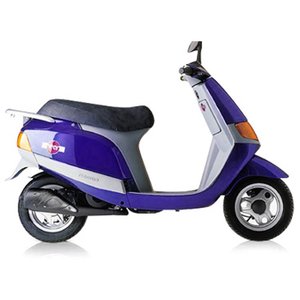Piaggio Sfera 80 (1991-1994) Review: A Nostalgic Ride Through Urban Practicality
Introduction
The Piaggio Sfera 80 represents a golden era of European scooters - a time when practicality, affordability, and simplicity ruled urban mobility. Produced between 1991 and 1994, this two-stroke workhorse was designed for navigating cramped city streets with Italian flair. While modern scooters chase horsepower and tech gadgets, the Sfera 80 reminds us of a purer philosophy: lightweight engineering, frugal operation, and unmistakable 90s style.
Having recently spent a week with a meticulously maintained 1993 example, I rediscovered why these scooters became icons for students, city commuters, and casual riders. Let’s dive into what makes this generation of the Sfera 80 tick – and why it still charms riders today.
Engine and Performance: Two-Stroke Simplicity
The Heartbeat of the City
At its core lies an air-cooled 75cc two-stroke single-cylinder engine (marketed as an "80" in some regions). With 8 PS (5.9 kW) on tap, acceleration feels surprisingly zippy for its class. The engine’s powerband is typical of two-strokes: sleepy below 4,000 RPM, then a sudden surge of urgency as the tiny piston spins toward its 8,500 RPM redline.
In stop-and-go traffic, this character shines. You’ll outpace most traffic lights with a satisfying braaaap from the exhaust, hitting 45-50 km/h (28-31 mph) effortlessly. Top speed settles around 70 km/h (43 mph) on flat roads – enough for urban sprints but taxing on longer stretches. The engine vibrates noticeably at higher RPMs, sending a buzzy feedback through the floorboard that adds to its analog charm.
Fueling and Efficiency
The Sfera 80 uses a basic carburetor system tuned for reliability. Cold starts require patience (and occasional choke fiddling), but once warmed up, it settles into a steady idle. Fuel economy depends heavily on riding style – expect 30-35 km/l (70-82 mpg) with gentle throttle use.
Two-stroke fans will appreciate the ritual of mixing oil with fuel (2% ratio, per Piaggio’s specs). Modern synthetic 2T oils reduce smoke compared to 90s mineral oils, but you’ll still leave a faint blue haze at full throttle – a signature trait that nostalgic riders adore.
Design and Ergonomics: Form Follows Function
Retro-Futuristic Styling
Piaggio’s designers nailed the early-90s aesthetic with clean, rounded bodywork that looks like a cross between a spaceship and a bar of soap. The streamlined nose, integrated turn signals, and minimalist dashboard scream "simplicity." Colors were bold – think pearlescent whites, metallic reds, and electric blues.
Standout features include:
- Step-through frame: Effortless mounting, even in tight skirts or suits
- Flat floorboard: Perfect for grocery bags or small packages
- Analog gauge cluster: Single speedometer with basic warning lights (no frills, no distractions)
Riding Position and Comfort
The Sfera 80 caters to riders of all sizes. At 81 kg (179 lbs), it’s easy to maneuver at walking speeds. The seat height of 760 mm (29.9 inches) suits shorter riders, while the wide, cushioned seat accommodates two adults – just don’t expect luxury on potholed roads.
Suspension consists of basic hydraulic forks up front and dual shock absorbers at the rear. They handle city bumps adequately but feel overwhelmed by larger imperfections. The 10-inch wheels contribute to quick steering, though they can feel skittish on gravel or wet roads.
Competition: How the Sfera 80 Stacks Up
Against the Japanese Contenders
In the 90s, the Sfera 80 faced fierce rivals:
- Honda Dio AF-18 (1992-1994):
- Similar 50-80cc displacement options
- More refined four-stroke engine (quieter, better mileage)
-
Superior build quality but less personality
-
Yamaha Jog R (1990-1995):
- Lighter weight (76 kg vs. Sfera’s 81 kg)
- Peppier acceleration but harsher ride quality
-
Less storage space under the seat
-
Aprilia SR 75 (1992-1996):
- Sportier styling and suspension
- Higher maintenance costs
- Better suited for spirited riding
Piaggio’s Edge: The Sfera 80 struck a balance between Italian design and everyday usability. While Japanese rivals were more reliable, the Sfera offered superior storage (including a lockable glovebox) and a smoother ride for taller riders.
Maintenance: Keeping the Sfera 80 Alive
Key Considerations for Owners
As a MOTOPARTS.store journalist, I’ve seen how proper care extends these scooters’ lives. Here’s your cheat sheet:
- Two-Stroke Oil:
- Use high-quality synthetic 2T oil (e.g., Motul 710) to reduce carbon buildup
-
MOTOPARTS.store recommendation: IPONE Factory Line 2T
-
Spark Plugs:
- Factory specs: NGK B9ES (standard) or BR9EIX (iridium)
- Check gap every 1,000 km (0.5 mm / 0.02 inches)
-
Upgrade to iridium for colder starts (NGK BR9EIX at MOTOPARTS)
-
Tire Pressures:
- Front: 1.2-1.5 bar (17-22 psi)
- Rear: 1.75-2.5 bar (25-36 psi)
-
Modern radial tires improve grip (Michelin City Pro)
-
Drivetrain:
- Direct drive system requires no chain maintenance
-
Replace drive belt every 10,000 km (Gates Powerlink Kit)
-
Brakes:
- Mechanical drum brakes front/rear
- Replace shoes if braking feels "mushy" (EBC Drum Shoes)
Common Issues to Watch For
- Carburetor Clogs: Clean every 2-3 years with ultrasonic treatment
- Exhaust Carbon Buildup: Decoke every 15,000 km
- Cracked Fuel Lines: Replace with ethanol-resistant hoses (Silicone Hose Kit)
Conclusion: A Timeless Urban Companion
The Piaggio Sfera 80 isn’t about speed or specs – it’s about the joy of unfiltered riding. In an age of touchscreen dashboards and ride modes, this scooter reminds us that mobility can be simple, affordable, and stylish.
Whether you’re restoring a classic or daily-riding a survivor, MOTOPARTS.store has the parts to keep your Sfera 80 thriving. From period-correct mirrors to performance exhausts, we’ll help you craft a scooter that’s uniquely yours.
Got a Sfera 80 story or project? Share it with us @MOTOPARTS.store – your vintage ride could feature in our next review!



















